Last Updated: 15/05/2025
Tapeworms in Dogs
Delve into the silent threat: tapeworms in dogs. Uncover causes symptoms and effective treatments for your dog..
Author: Dr Brittany Ward BVSc
Reading Time: 49 minutes - long read
The "All-In-One" parasite preventative is becoming increasingly popular with many owners believing that a single chew is providing complete parasite protection, but an often forgotten parasite could be lurking in your dog's digestive tract. Many products claiming to "cover everything" don't include tapeworm prevention. This intelligent worm often causes little to no harm to its host, meaning many dogs could be harbouring a silent infection.
If left to fester, the infection becomes severe and causes illness in your dog, with puppies being even more at risk. Tapeworms are also a serious human health risk with people, especially children, able to become infected via their dogs.
There is hope on the horizon though! Just like other parasites, tapeworms can be prevented with a regular over the counter treatment. Prompt recognition, diagnosis and treatment can also mean infections can be resolved easily. This article will dive deeply into the signs, life cycle, prevention and treatment of the tapeworm so that you can keep all the members of your family safe.
Recognising Tapeworm Infections

Chances are, you are already familiar with Tapeworms. These are an intestinal worm that usually appears as a long, flat, white worm. You may have seen them hanging from a pet's bottom before and maybe even thought it was a piece of string! However, many tapeworm infections can be silent. So how do you know if your dog has tapeworms?
First of all, it's important to know how to differentiate a tapeworm from other intestinal worms. Roundworms, hookworms and whipworms typically have smooth, rounded bodies. They are usually smaller, with Roundworms being up to 15 centimetres and Hookworms being a couple of centimetres long. Whipworms typically have a rounded body with a thin tail like a whip and are around 4.5-7.5cm long. If worms are passed in faeces, typically the whole worm is passed. Now let's look at tapeworms specifically.
What Types of Tapeworms Affect Dogs?
Tapeworm refers to a few different species of flat worms with segmented bodies. They are typically white, often looking like a tape when they are intact, but can also pass small white segments in the faeces, which may look like grains of rice under the tail or in the faeces. There are 4 main types of tapeworms that can affect Australian dogs
Flea Tapeworm
Dipylidium canis, the Flea Tapeworm, is the most common tapeworm found in dogs. This worm is typically identified by white, moving segments (called proglottids), in the faeces or around the bottom that are the size of a rice grain. These mature proglottids are larger than those closest to the head and are typically longer than they are wide. This worm can be up to 50 centimetres long.
Taenia Tapeworms
There are several species of tapeworms in the Taenia family that can affect our dogs:
- Taenia ovis - Sheep Measles
- Taenia hydatigena - Long-necked Bladder Worm
- Taenia pisiformis (cysticercus)
- Taenia serialis - Coenurosis or Canid Tapeworm
Taenia is a long worm with its smallest segments near its head and the largest proglottids are shed in faeces or may crawl out of the bottom. The moving white segments have been described as being like 'maggots'. Compared to the Flea Tapeworm, the segments are wider than they are long. Worms of the Taenia species can be several metres long.
Hydatid Tapeworms
Hydatid Tapeworms, or Echinococcus granulosus, is the most important tapeworm of concern in dogs. Although it is not overly common, nor does it cause considerable harm to our dogs; rather, the Hydatid Tapeworm poses significant human health risks.
Echinococcus granulosus is a very small tapeworm being approximately 3-5 millimetres in length and made up of only 3-4 segments. Unlike other tapeworms, this worm passes eggs in the faeces, not segments. Because the eggs are microscopic, owners will not be able to identify if an infection is present this way and will need to monitor their dog for other signs of a tapeworm infection.
Zipper Worm
The Zipper Worm, Spirometra erinacei, is predominantly a tapeworm of cats, however, some cases have been reported in dogs as well. This worm has a central reproductive system in each segment, surrounded by flat tissue. This gives the appearance of a zipper running down the worm. Adult worms can reach up to 1.5 metres in length. When the segments are shed in the faeces, they appear with a raised central oval and a thin tape appearance on either side.
Even though Zipper Worms are not common in dogs, they are important to note because their treatment dose varies from that of other tapeworms.
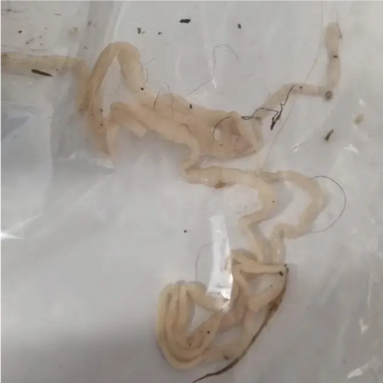
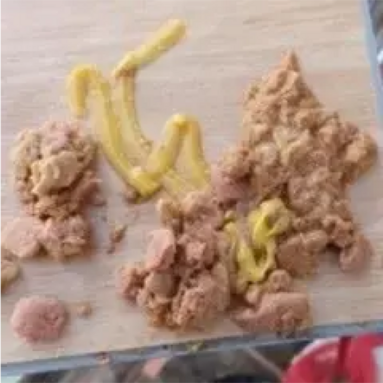
Symptoms of Tapeworms in Dogs
Tapeworms are often considered a 'smart worm' because they inflict minimal damage on their host and often don't cause any symptoms. Tapeworms do not feed off the host themselves, instead they feed on the dog's intestinal content. They mainly cause discomfort or reduce nutrient absorption.
Most cases of tapeworm are identified when owners visualise the segments around their dog's bottom or in faeces while cleaning up after their dog.
However, some dogs may show signs of disease, particularly those with high worm burdens, larger species of tapeworms or puppies and senior dogs.
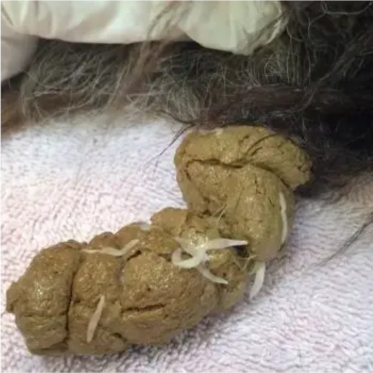

White segments like rice grains or maggots on faeces or under tail

Scooting or dragging the bottom on the ground

Biting or chewing around the bottom

Illthrift

General Malaise

Weight loss

Ravenous appetite

Diarrhoea

Vomiting (Sometimes with worms in heavy burdens)

Abdominal pain or discomfort
How Do Dogs Get Tapeworms?
Life Cycle of Dipylidium Caninum

While most intestinal worms can be contracted directly from eating eggs or larvae, tapeworms have an intermediate host, also called a paratenic host. This means that part of their life cycle exists within another species before infecting your dog. In order for your dog to become infected with tapeworm, they must eat the paratenic host.
A dog that is infected with adult tapeworms will shed proglottids (segments), containing tapeworm eggs, in their faeces. The proglottids will break open and release the eggs in the faeces where they can be ingested by the paratenic host and enter the larval phase of the tapeworm life cycle.
The Flea Tapeworm (Dipylidium Caninum) uses fleas as its intermediate host. Flea larvae consume the released eggs from faeces and the larval stage of the tapeworm and flea will develop together. Your dog will then consume a flea infected with the larval cysts, often while grooming or chewing at an itch. The larval cysts will break open and develop into adult worms. This complete life cycle takes 2-3 weeks.
Hydatid Worms and worms of the Taenia species have a variety of paratenic hosts, depending on the specific worm species involved. Possible hosts can include sheep, cattle, pigs, goats, rabbits and hares. Echinococcus granulosus can also use macropods, such as Kangaroos, as a paratenic host. Hydatid worms have a life cycle taking approximately 6-9 weeks.
The paratenic host will often consume the tapeworm eggs while eating grass that has been contaminated with dog faeces. The eggs will then hatch and the tapeworm larval stages will form cysts within the tissues, particularly muscles, of the host. Dogs will become infected by eating the raw meat that contains larval cysts, which will then develop into adult worms.
Unlike other tapeworms, the Zipper Worm (Spirometra erinacei) has at least two intermediate hosts. The first host is a small water based crustacean called Copepods. These are then ingested by the second intermediate host; frogs, snakes, lizards, chickens, pigs, birds, etcetera. This ingestion often occurs passively while they are drinking the water. Dogs can become infected via two methods:
1. They may drink contaminated water, becoming a secondary intermediate host. In this case the larvae develop into a new stage where they are called sparganum and these infect the dog's muscles and tissues as cysts.
2. They could consume the second intermediate host and become infected with adult worms, which reside in the intestinal tract.
The Zipper Worm's full lifecycle takes around 6-10 weeks (48-67 days), and like Hydatid worms, its adult form can survive within a cat for several years.
Diagnosis of Tapeworms
It's important that owners are aware of the signs of tapeworms in their dogs. This way they can take their dog to the vet if they suspect a tapeworm infection. A diagnosis will then be made by the examining veterinarian.
It's important to not only take your dog to the vet, but also to collect a sample of the faeces (use gloves and wash your hands), as well as any proglottids, or worms you may have seen on your dog or in their faeces. The vet will examine the proglottids microscopically to identify the tapeworm infection present. Your vet may also perform a microscopic faecal examination to determine if there are eggs present in the faeces.
Treatment of Tapeworms

When it comes to Tapeworms, the magic word is 'Praziquantel'. Tapeworms are treated, and prevented, with the active ingredient Praziquantel. However, the dose used in preventatives is not sufficient for treatment. Identification of the type of tapeworm present is important to determine the treatment dose, particularly for Spirometra, which must be treated with 4 times the standard labelled dose. Once your vet has made a diagnosis of a tapeworm infection they will begin treatment with either an oral or injectable formulation.
An intestinal worming treatment course for dogs will typically be prescribed to ensure that treatment covers the entire life cycle of the worms, that all worms involved in the infection are eliminated and that re-infection from the environment cannot occur. For severe or persistent infections, your vet may prescribe year long treatment which is necessary to ensure the problem is resolved.
When the treatment is administered, it will dissolve the tapeworms within the digestive tract, this means that owners often won't see their dogs passing the worms in their faeces.
Prevention of Tapeworms
Adult worms can survive for years without causing symptoms, which means that prevention is essential for controlling tapeworms. Without prevention, your dog could be harbouring a number of large adult tapeworms making them chronically unwell, or contaminating the environment and putting your family at risk. There are several steps that can be taken to reduce your dog's risk of getting tapeworms:
- Clean up faeces regularly and bury it or dispose of it in a bag in the trash
- Prevent dogs from hunting and eating small prey, rodents or hares
- Control rodent populations
- Provide clean fresh water that is kept away from faeces
- Avoid feeding raw meat or offal
- Control the flea population
- Use regular tapeworm prevention
Dog tapeworm tablets and the use of a praziquantel containing preventative is essential for avoiding a tapeworm infection and should be used in dogs Australia wide. Be sure to check the ingredients when choosing wormers, as not all 'All-In-One' products or 'Allwormers' cover tapeworms.
Top Recommended Tapeworm Preventatives:
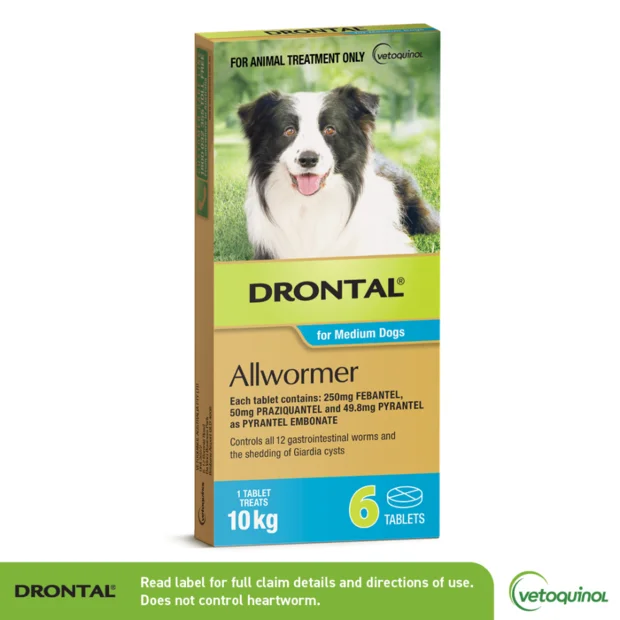
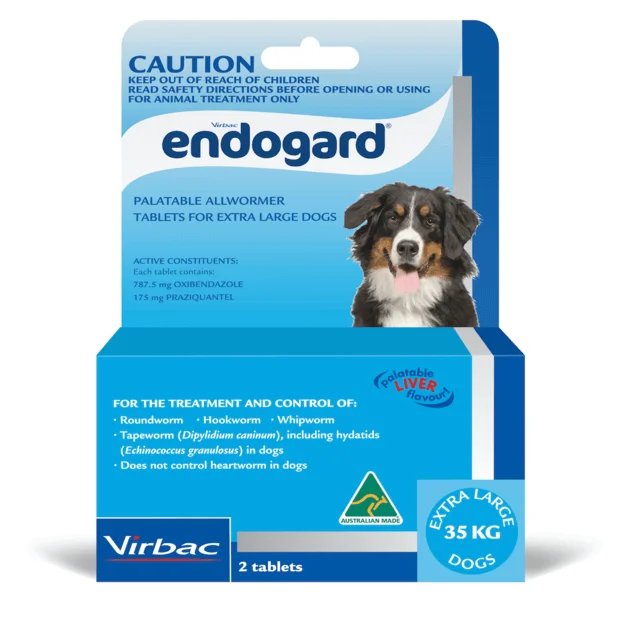
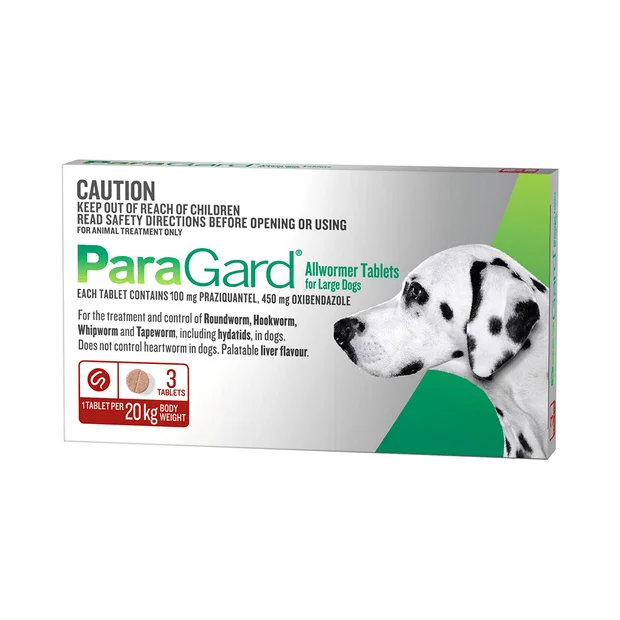
The Importance of Flea Prevention
The most common cause of tapeworm in dogs is the Flea Tapeworm. This means that flea prevention plays an important role in controlling tapeworm. Even if a tapeworm treatment course is completed, a dog with fleas could easily become reinfected. All fur-family members should be on a flea preventative as the flea tapeworm could be spread between dogs and cats in the household. Infected fleas can also be introduced to the household from other visiting pets, wild animals and even on your clothing. A preventative can will significantly reduce your dog's risk of becoming infected with flea tapeworm.
Flea Prevention is also essential in preventing human members of the family from contracting tapeworm by controlling your exposure to fleas and the number of fleas in the environment.
Fleas can persist in the environment which may make complete control of a flea infestation seem impossible. It's important to combine regular flea preventatives with environmental management to get on top of the problem. Our article How To Treat A Dog With Fleas goes through this process in more detail.
Top Recommended Flea Preventatives:
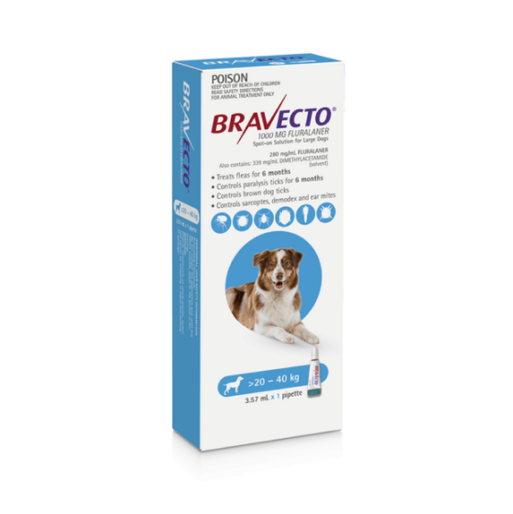
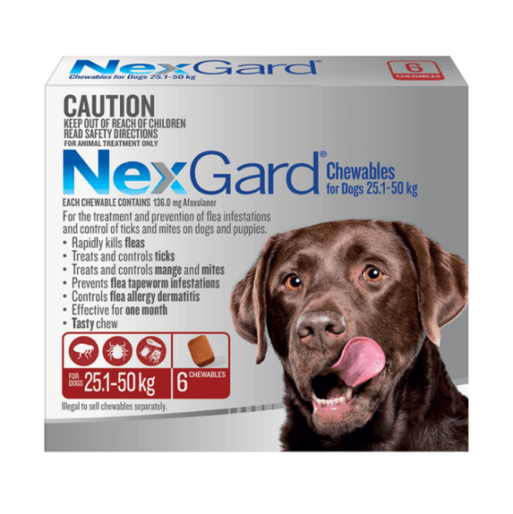
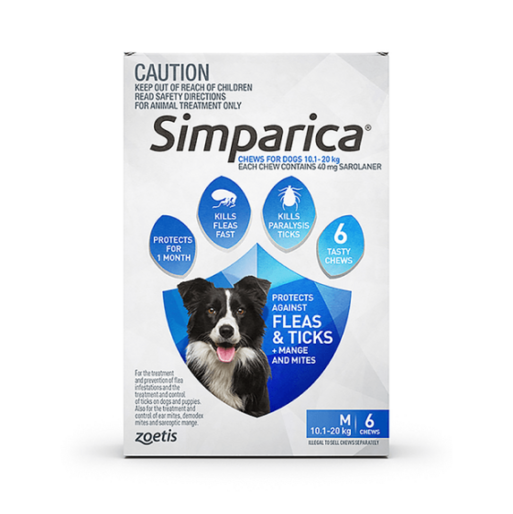
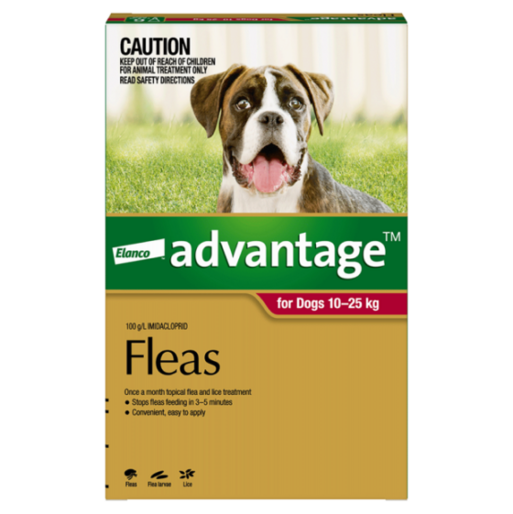
Not sure what parasite preventatives are the best for your dog? Check out our Dog Guide to Worming, Flea and Tick Prevention or feel free to start a Live Chat with one of our Vet Squad members.
Can I Get Tapeworms From My Dog?

One of the leading motivators for tapeworm prevention in our pets is the risk to human health. The tapeworms that our pets can harbour and spread into the environment can also potentially affect us. Humans can become infected with both adult tapeworms and larval stages by consuming contaminated raw meat or consuming tapeworm eggs from faeces.
As mentioned above, the Hydatid Worm, Echinococcus granulosus, poses the greatest risk for humans. The larval stages of these tapeworms form cysts in the body's tissues, such as under the skin, urinary tract, eye, nervous system, lungs or abdominal organs, which could cause a variety of different symptoms. However, liver and respiratory based symptoms seem to be the most common in people. The cysts can also rupture causing a reaction in the human host, such as fever, rash, immune response and anaphylactic shock. Treatment of Cystic echinococcosis in humans is treated with surgical removal of cysts or prolonged management with medications.
Although you may not be actively eating dog faeces, eggs in faeces can contaminate food, drinking water or could be picked up from petting your dog's coat. Children are the most at risk of becoming infected with tapeworms, but anyone can potentially be infected. To prevent you or your family from getting tapeworm, make sure you:
- Use tapeworm preventatives for your pets
- Use flea prevention on your pets
- Clean up faeces regularly and bury it or dispose of it in a bag in the trash
- Wash your hands after handling faeces or touching your pets
- Wash your hands before eating and wash food before eating
- Make sure all meat is cooked properly
Further Reading
Want to know more? Check out our Discover Page for more tips on keeping your pets happy and healthy.
References:
Australasian Animal Parasites Inside and Out
VIN - Taenia Species Tapeworms in Dogs and Cats
CVE - Canine Spirometra Infection
BowWowMeow Pet Insurance - Tapeworm in Dogs and Cats
Virbac - Intestinal Worms in Dogs and Cats
East Bundaberg Vet - Tapeworms that Affect Cats and Dogs
World Health Organisation - Echinococcosis
Companion Animal Parasite Council - Echinococcus Spp.
University of Queensland - Taeniid Metacestodes
Tapeworms in Dogs and Cats - MSD Vet Manual
Taeniasis, Cysticercosis and Coenurosis - The Centre for Food Security and Public Health